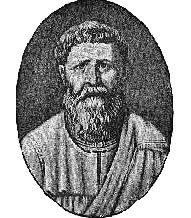|
The Visible and Invisible
Church
In the early 400s Augustine began
to develop a rather clear idea of the difference between the visible and
the invisible church: the visible church included all professed Christians – some
of which were Christian in name only.
The "invisible" church was made up
of only the true believers. And here, only God alone, who searches human
hearts, knows who makes up this church.
[This idea was quite novel at the
time – but came to be widely accepted after Augustine. John Calvin, in the
mid-1500s, pushed this concept strongly in his own doctrine of the church.]
Human Sin/Divine Providence
In his own theology, Augustine strongly
contrasted God's goodness (in creation) with human rebelliousness, his
habitual slavery to his passions. Unlike the neo-Platonists, Augustine
saw sin in humans, not in the world of physical matter.
He had a strong sense of the total
sovereignty/providence of a loving and gracious God. To Augustine, true
freedom for man consists in the acceptance of God's grace – given to those
whom God has called or elected to salvation (foreknown through God's eternal
mind).
But like the neo-Platonists, Augustine
understood that it is God who enlightens our souls – the portion
of our being that is immortal and close to God (distinct from the body).
We have no true knowledge apart from God's enlightenment or revelation.
Thus, the highest act of a Christian
is to lovingly desire God, to rest one's soul in Him. In God all things
are to be found in truth and fulness. To focus ones desires on the world
is to sell one's life short: exchanging the eternal for the temporary (amply
demonstrated in his time in the collapse of the Western Roman Empire in
410).
| 


 Augustine's Youth
Augustine's Youth
 Augustine's Christian Conversion
Augustine's Christian Conversion
 Augustine's Struggle Against
Augustine's Struggle Against Augustine's Other Theological
Augustine's Other Theological Go
to the history section:
Post-Nicene Christendom
Go
to the history section:
Post-Nicene Christendom


